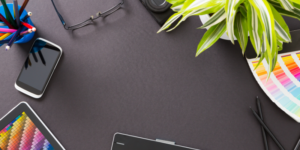Digital design is constantly evolving, and one trend that has gained prominence in recent years is Dark Mode. This design option, which replaces the traditional light color palette with darker tones, has been increasingly embraced and has become a preference across various platforms and applications. In this article, we will explore the growing popularity of Dark Mode in digital design, examining its advantages, challenges, and impact on user experience.
What is Dark Mode?
Before delving into the aspects of Dark Mode, it is important to understand what it entails. Dark Mode is an alternative theme or display mode in digital interfaces, where the background is dark, and text and graphical elements are displayed in light colors. This option offers a visually distinctive experience compared to the traditional mode, where the background is light, and the text is dark.
Advantages of Dark Mode
Dark Mode presents several advantages for both users and designers. Some of the notable benefits include:
Reduced eye strain: Dark Mode is known for reducing eye strain, especially in low-light environments. The dark colors provide a smoother contrast and reduce excessive brightness, resulting in a more comfortable experience for users.
Energy efficiency on OLED devices: Devices with OLED screens, such as smartphones and tablets, consume less power when displaying content with a dark background. This is because the pixels on these devices are turned off when displaying absolute black, leading to greater energy efficiency.
Highlighting content and visual elements: Dark Mode can enhance the visibility of content and visual elements, making them more prominent. The light colors of text and graphical elements stand out against the dark background, creating an interesting and attention-grabbing contrast.
Challenges of Dark Mode
Although Dark Mode has its advantages, its implementation also presents challenges for designers. Some common challenges include:
Text legibility: Not all content is equally legible on a dark background. Some light colors may become illegible or cause eye strain when used in contrast with a dark background. It is essential to find an appropriate color combination to ensure text legibility.
Consistency of experience: The adoption of Dark Mode can lead to variation in the user experience, as not all platforms and applications support it. Some users may prefer the dark mode, while others may prefer the light mode. Designers must ensure that the transition between modes is smooth and that the user experience remains consistent.
Adaptation of visual elements: When designing for Dark Mode, designers need to consider the adaptation of visual elements such as logos, icons, and images. These elements may require adjustments to fit the aesthetic of the dark background and maintain visual coherence.
Impact on User Experience
Dark Mode has a significant impact on user experience. In addition to providing a visually distinctive experience, it can convey a sense of elegance, modernity, and sophistication. Many users report preferring Dark Mode for its appealing aesthetics and for creating a more immersive environment while using applications and websites.
Implementing Dark Mode
Effective implementation of Dark Mode requires care and attention to detail. Some important aspects to consider include:
Usability testing: It is crucial to conduct usability tests with real users to assess the legibility, contrast, and usability of Dark Mode. These tests help identify potential issues and improve the user experience.
Mode switching: Offering users the option to choose between Dark Mode and the light mode is a recommended practice. This allows users to personalize their experience based on their individual preferences.
Visual coherence: When designing interfaces with Dark Mode support, it is essential to maintain visual coherence between the light and dark modes. Visual elements should be adapted consistently to ensure a cohesive and intuitive experience.
Conclusion
Dark Mode continues to gain popularity in digital design, offering an appealing visual experience, reduced eye strain, and energy savings on OLED devices. While its implementation presents challenges, the benefits outweigh the difficulties. As more platforms and applications embrace Dark Mode, designers must strive to create consistent, legible, and visually pleasing interfaces for users. The future of digital design undoubtedly includes Dark Mode as a prominent trend that will continue to shape aesthetics and user experience.
Dark Mode has truly revolutionized the digital design landscape, and its popularity shows no signs of slowing down. As designers continue to explore the possibilities of this design trend, there are several key considerations to keep in mind.
Firstly, it’s important to understand that Dark Mode is not a one-size-fits-all solution. While it may be visually appealing and offer numerous benefits, it may not be suitable for all applications or user demographics. Designers should carefully evaluate the target audience and the specific context in which Dark Mode will be implemented. For example, Dark Mode may be more suitable for applications used in low-light environments, such as photo editing tools or entertainment platforms, where it can enhance the overall user experience.
Another aspect to consider is the balance between aesthetics and functionality. While Dark Mode can create a sleek and modern look, it should not compromise the usability and readability of the interface. Designers must pay close attention to contrast ratios, font choices, and other visual elements to ensure that the content remains legible and accessible to users.
Furthermore, the implementation of Dark Mode should be consistent across different platforms and devices. Users have come to expect a seamless experience when transitioning between light and dark modes, and any inconsistencies in design or functionality can lead to a disjointed user experience. It’s crucial for designers to maintain visual coherence and ensure that the switch between modes is smooth and intuitive.
Accessibility should also be a top priority when designing for Dark Mode. While it can provide benefits for many users, it’s important to consider those with visual impairments or specific accessibility needs. Designers should ensure that appropriate accessibility features, such as adjustable contrast or alternative color schemes, are in place to accommodate a diverse range of users.
As with any design trend, it’s essential to stay informed and adapt to evolving user preferences. While Dark Mode is currently on the rise, it’s important to continually assess its effectiveness and the reception from users. User feedback, usability testing, and analytics can provide valuable insights into how Dark Mode is being perceived and utilized, allowing designers to make informed decisions and iterate on their designs.
In conclusion, Dark Mode has emerged as a significant trend in digital design, offering a visually striking and immersive experience for users. Its benefits, such as reduced eye strain and energy efficiency, make it a compelling option for many applications. However, designers must approach its implementation with care, considering factors such as usability, accessibility, and visual coherence. By understanding the nuances of Dark Mode and adapting it to specific contexts, designers can create interfaces that are both aesthetically pleasing and functional, ensuring a delightful user experience for all. As technology continues to advance and user preferences evolve, Dark Mode will undoubtedly remain an influential force in the world of digital design.



